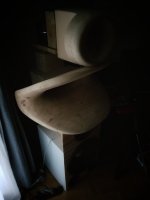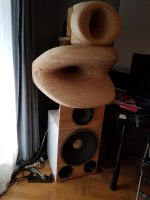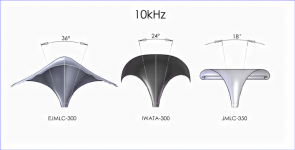My Raals are still going strong, after being hornloaded down to 2kHz for 2-3 years. Going to add another compression driver for upper midrange to see how that sounds like. I have had an allergy for anything heavier than .001 grams-something in the high frequency for a while.
What did you go for instead? Plasma? Bluetooth portable speaker?
What did you go for instead? Plasma? Bluetooth portable speaker?
My Raals are still going strong, after being hornloaded down to 2kHz for 2-3 years. Going to add another compression driver for upper midrange to see how that sounds like.
Interesting. Please keep us posted. I have TPL-150H and have considered a 2" CD for the midrange but have to buy the CD and grew concerned of the center to center distance between such large tweeter and midrange, at 2kHz. Interested in learning how things pan out for you.
One word. Iwata.  it shrinks a large horn vertically and also has a more relaxed sound than round horns. This system has to be time-aligned in DSP for space constraints. The directivity suffers so you have to sit and stare into the throat to get good highs. And with a deep horn it is no longer in supertweeter territory. I almost need another pair of Raals above ~10kHz.
it shrinks a large horn vertically and also has a more relaxed sound than round horns. This system has to be time-aligned in DSP for space constraints. The directivity suffers so you have to sit and stare into the throat to get good highs. And with a deep horn it is no longer in supertweeter territory. I almost need another pair of Raals above ~10kHz.
Attachments
Last edited:
One word. Iwata.it shrinks a large horn vertically and also has a more relaxed sound than round horns. This system has to be time-aligned in DSP for space constraints. The directivity suffers so you have to sit and stare into the throat to get good highs. And with a deep horn it is no longer in supertweeter territory. I almost need another pair of Raals above ~10kHz.
Your nice and dark room is...eeee...dark!
Iwata was in the cards. Still seems c-to-c would be large for 2kHz xo. But then I haven't tried it.
DSP time alignment is part of the system. No problem.
I wouldn't use the CD horn above 2kHz so directionally in the treble wouldn't be that big of an issue.
How low do you plan to take the midrange horn? 2kHz down to...?
Forgot to switch the light on. I will start with 1400Hz and then I don't know. People use Raal from 12kHz, but I think that is wasteful.
The Fane Studio 8M is not doing much at the moment and probably never will. The 15" will hopefully be replaced by a midbass compression driver soon.
The Fane Studio 8M is not doing much at the moment and probably never will. The 15" will hopefully be replaced by a midbass compression driver soon.
Attachments
Forgot to switch the light on. I will start with 1400Hz and then I don't know. People use Raal from 12kHz, but I think that is wasteful.
Starting at 1400Hz for the Raal or for the midrange CD? Rather low for the Raal and rather high for the midrange
Wow, those really looked like a mouth with fully lips !
If you favor large Lips, the EJMLC horn profile produces a wide high frequency horizontal polar response.
Attachments
Iwata like
Interesting jmove; is the horn profile based upon one of the jmlc spreadshits ?
May you share the details of the making process ?
Thank you
Forgot to switch the light on. I will start with 1400Hz and then I don't know. People use Raal from 12kHz, but I think that is wasteful.
The Fane Studio 8M is not doing much at the moment and probably never will. The 15" will hopefully be replaced by a midbass compression driver soon.
Interesting jmove; is the horn profile based upon one of the jmlc spreadshits ?
May you share the details of the making process ?
Thank you
When the project allows for it, in 3-way, I do not use a single 6-7" cone driver for the mid range, but a group of 6 x 3" Aluminum cone full-range drivers. Those have the first problem at 11k (a 3dB high peak), so they allow the above explained approach to bloom to it's full potential. And they will surpass any single cone driver in dynamics and clarity, no matter the kind.
And so on and so forth...thank you for the attention!
Old thread I know......but mind sharing how you would align those 6 fullrange drivers?..........vertical array, cluster, mmmmtmmmm?
Well, the point of all things is to use them if and where they make a difference.
I can't stress enough that system integration makes a world of difference.
You can't just slap two drivers together and hope for the best...
As for the ribbons, the use of full DSP capability doesn't fit them well. Actually, that doesn't fit any tweeter, but much larger surface area (AMTs) or stiff suspension (dome tweeters) will cope better with that problem. I'll explain.
With DSP, people usually go for high order slopes, like 48db/oct or even brickwall.
Let's say we have a 2-way with 7" bassmid and a 140-15D ribbon. The crossover point is at 3k and we use a brickwall filter.
In that situation, what SPL this 7" will put out at 2999Hz, the tweeter will have to do same at 3001Hz.
We are talking here of 6:1 or 5:1 surface area ratios in favor of the bassmid, which also has much greater directivity at the same frequency.
Asking that system to behave as you would wish is simply not possible. If you want something to match something, without blending in the crossover region, those two somethings will have to be the same.
If they are not, then the smaller one of the two (in this match made in digital heaven) will produce proportionally more distortion.
The power of musical signal drops with rising frequency and this fact is used for decades in loudspeaker system integration with great success, for alleviating tweeters from excessive stress and reducing the overall distortion at and around the crossover frequency.
Using sharp slopes in DSP based systems negate this.
Let's take the same 7" bassmid and a 140-15D ribbon system, but now with 2nd order Bessel or Linkwitz-Riley at 3k.
These filter types will have -5 and -6dB at the crossover point, respectively, and a very gentle slope between the crossover point and zero (maximum) level, stretching to about 10k.
If you use that kind of filtering at 3k, you have halved the tweeter excursion at the crossover point and you're counteracting the musical power response with a gentle rise from -5-6dB at 3k to zero at 10k.
There is catch, though. You should have a very flat and far-reaching bass-mid and you'll have increased between 2k and 5k. Therefore, a physical time alignment is necessary, so you would have the crossover region beaming to propagate horizontally through the space (very important stuff).
In practice, bass-mids are not that good, have garbage above 4k, nor the RAAL are flat all the way down, so I use filters that are closer to Butterworth than to Bessel or L-R, to get what I want in acoustical domain.
The goal is to get the best impulse response possible, that looks like it's coming from a single speaker. That means that phase tracking and time alignment are accurate, so the blending is accurate. Combined impulse response has to measure good, if you're going to move to the next step - voicing it by ear.
Attached here is how a S-S Illuminator 7" 4Ohm + RAAL 140-15D look like in response together, nothing but 2nd order, with Zobel network on S-S:
Now, if isn't done right down to the detail (and that usually takes time), all talk of realistic sound of this or that, or micro-macro dynamics is pointless...Especially if you don't have your own recordings to use as a reference point. I do and people that I design the speakers for, do also, and telling here what they think of the monitors would feel like tasteless bragging.
Simply, the sound is made by the complete interaction between components.
For some anomalies, you compensate, some are sorted out on the own, some you will never solve, whatever you speaker integration approach is.
In the end, once you do everything right with the crossover, baffle size, time-alignment, dampening, voicing, positioning in the room...you're left with inherent quality of the drivers used to define the sound.
While RAALs are not ideal, nothing is, they will do 2.5-3k with no problems whatsoever, regarding dynamics and distortion, when used in accordance to long established good practices in speaker integration, and from that point on, it will be very, very hard to match that performance. Sounds stupid when I say it, but I'm not the only one, so I'm not blushing when saying it.
As you can see, I reverted back to 2nd order filters (in both 2-way and 3-way) as I get the best combined impulse response with them. While the cleanup of bass-mid's upper-end garbage is not as effective as with higher orders, the sound is better than if the impulse response does not look like this.
When the project allows for it, in 3-way, I do not use a single 6-7" cone driver for the mid range, but a group of 6 x 3" Aluminum cone full-range drivers. Those have the first problem at 11k (a 3dB high peak), so they allow the above explained approach to bloom to it's full potential. And they will surpass any single cone driver in dynamics and clarity, no matter the kind.
And so on and so forth...thank you for the attention!
Hi RAAL,
Would a 70-20XR intergrate well with a Volt VM752, and if so, what crossover frequency would you use? The VM752 has a very wide bandwidth and great resolution but sometimes I wonder if using maybe qnty 4x ScanSpeak 10F/8424 in series-parallel wouldn't be better maybe in a MMTMM configuration. The sensitivity of the four 10F's would be a natural match to the 70-20XR's circa 92dB 6.3ohm tap.
Also, the recommended XO for the 70-20XR says that it will be 4th order with the addition of a coupling cap. Is there a way to get the slope closer to 2nd order to blend in better with the four SS 10F's?
Thanks,
X
- Status
- This old topic is closed. If you want to reopen this topic, contact a moderator using the "Report Post" button.
- Home
- Loudspeakers
- Multi-Way
- World's Best Tweeters Face-off :: Subjective comparison


